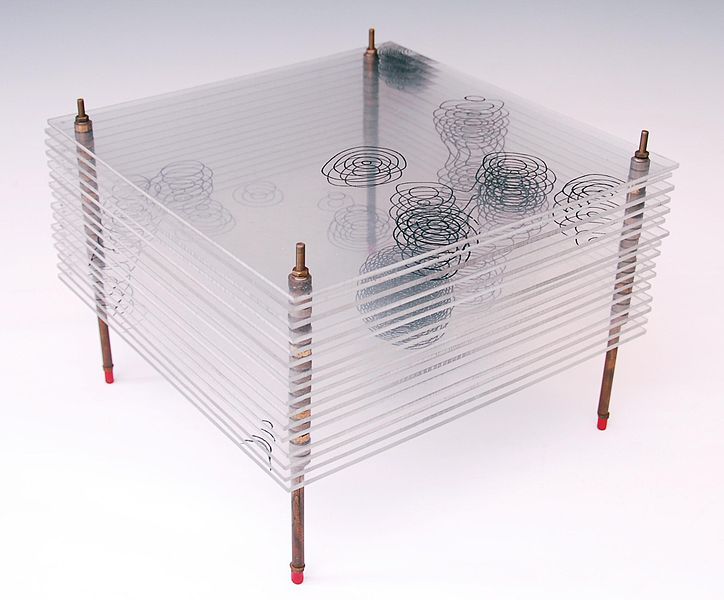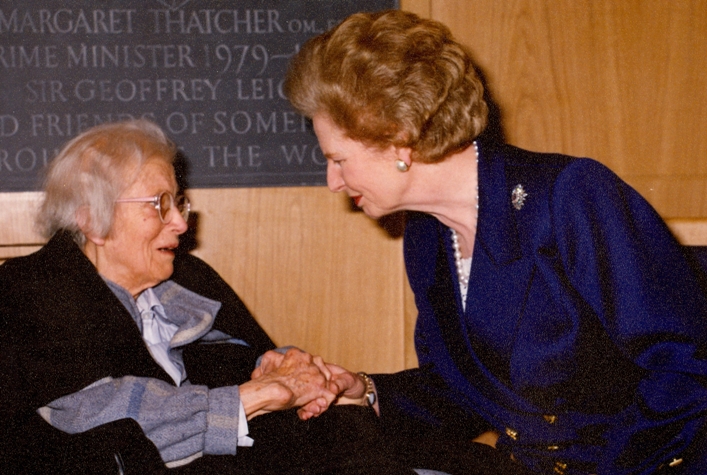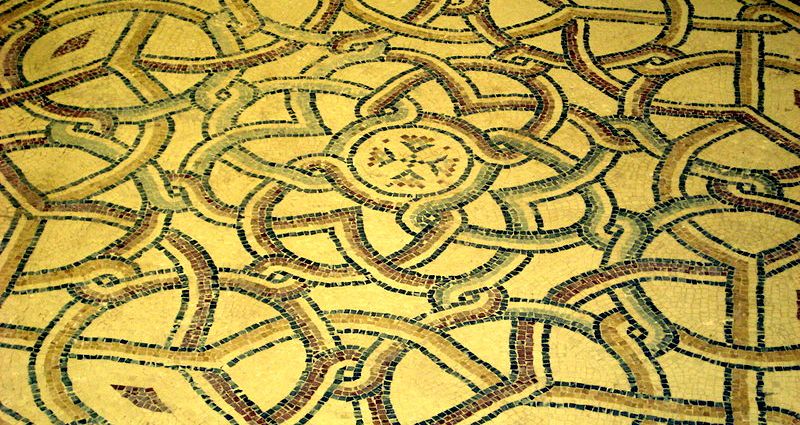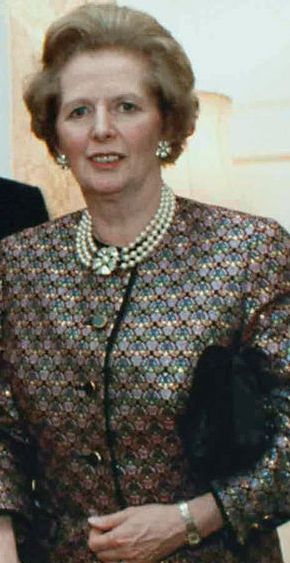 About a year ago I sat in the Members’ Room at the Royal Society as Professor Judith Howard FRS, once a doctoral student of Dorothy Hodgkin’s, explained how crystallographers worked in the early days. She showed me how Dorothy would begin by calibrating the black circles in an X-ray diffraction pattern by eye, to begin the long process of assembling from the shadows cast by an X-ray beam the complex three-dimensional arrangement of atoms in the molecule. Hanging on the wall outside was a Henry Moore drawing of Dorothy’s arthritic hands , the hands she said she thought with.
About a year ago I sat in the Members’ Room at the Royal Society as Professor Judith Howard FRS, once a doctoral student of Dorothy Hodgkin’s, explained how crystallographers worked in the early days. She showed me how Dorothy would begin by calibrating the black circles in an X-ray diffraction pattern by eye, to begin the long process of assembling from the shadows cast by an X-ray beam the complex three-dimensional arrangement of atoms in the molecule. Hanging on the wall outside was a Henry Moore drawing of Dorothy’s arthritic hands , the hands she said she thought with.
What intrigued me in seeing the combination of skills she needed, not only mathematics but hand and eye co-ordination and vision to work out how the thousand atoms in say the Vitamin B12 molecule fitted together. It was somewhere between chess and Rubik cube- a giant jigsaw puzzle where she couldn’t see the picture, or even all the pieces. I met Judith as part of my research for a radio play about Dorothy Hodgkin and Margaret Thatcher, two extraordinary women who reached the pinnacle in their chosen spheres –and were about as different as any two women could be. From 1943 to 1947 Hodgkin was the then Margaret Roberts’ s chemistry tutor at Somerville College, Oxford from 1943 -1947 when Hodgkin was working at the cutting edge of X ray crystallography. In her fourth year Thatcher worked in Hodgkin’s lab on a molecule called Gramicidin S, which originated in the Soviet Union and had some antibiotic properties.
I met Judith as part of my research for a radio play about Dorothy Hodgkin and Margaret Thatcher, two extraordinary women who reached the pinnacle in their chosen spheres –and were about as different as any two women could be. From 1943 to 1947 Hodgkin was the then Margaret Roberts’ s chemistry tutor at Somerville College, Oxford from 1943 -1947 when Hodgkin was working at the cutting edge of X ray crystallography. In her fourth year Thatcher worked in Hodgkin’s lab on a molecule called Gramicidin S, which originated in the Soviet Union and had some antibiotic properties.
They stayed friendly. Hodgkin visited Chequers, Thatcher’s official country residence in the 1980’s when she was President of the Pugwash Conference, a group of concerned scientists whose objective is the elimination of all weapons of mass destruction. That meeting is at the heart of the play about these two towering women, so different in style and political opinion, yet full of common points of reference. One who notoriously relished conflict, the other known for getting on with almost everyone. In the 1940’s Margaret was Dorothy’s pupil, whilst almost 40 years later she had probably more power than any woman alive. Arguably, though Hodgkin changed the world even more profoundly than Thatcher did.
I wanted to find ways of using the language that Thatcher and Hodgkin shared to tell their story. That meant thinking of Thatcher as a scientist. Certainly it was one of the ways she liked to think of herself. When she addressed the Royal Society as Prime Minister she proudly identified herself as a chemist, a crystallographer and most of all as Dorothy’s pupil. She worked for four years as a chemist, and it remains an oddity worthy of mention that both Margaret Thatcher and Angela Merkel studied science unlike any male leader of either country. So science shaped her, and so did Dorothy.  Dorothy grew up steeped in pattern. She worked with her archaeologist father on reconstructing mosaics, and her mother was an expert in ancient textiles. Margaret lived above a grocer’s shop where she heard her lay preacher father’s homilies and went to chapel five times on Sundays. The fundamental principles of science she learned confirmed for Thatcher her unshakeable certainty in right and wrong. As she put it later: “As a Methodist in Grantham I learned the laws of God, when I read Chemistry I learned the laws of Science, which derive from the laws of God, and when I studied for the Bar I learnt the laws of man.”
Dorothy grew up steeped in pattern. She worked with her archaeologist father on reconstructing mosaics, and her mother was an expert in ancient textiles. Margaret lived above a grocer’s shop where she heard her lay preacher father’s homilies and went to chapel five times on Sundays. The fundamental principles of science she learned confirmed for Thatcher her unshakeable certainty in right and wrong. As she put it later: “As a Methodist in Grantham I learned the laws of God, when I read Chemistry I learned the laws of Science, which derive from the laws of God, and when I studied for the Bar I learnt the laws of man.”
Thatcher’s idea of science as a series of laws was very different from Hodgkin’s exploration and receptivity to the molecules themselves.When Dorothy was asked what she thought the study of chemistry might offer she said: “I think it should interest you in the problems of finding out as much as you can about the way we work, the way matter is put together.” Thatcher worked more like a chemical engineer, her brilliance lay in knowing how to change the environment to produce the reaction she wanted. Both women had the great skill of choosing their problems wisely. But there was a fundamental difference one saw things always in three-dimensional complexity and the other as a series of binary oppositions.
Hodgkin, like her doctoral supervisor, JD Bernal was of the left. Were their politics connected with the techniques they used to reveal the fundamental invisible structures of the world around them?
When the x-ray was added to the prosthetic tools for making things visible that began when scientist used the telescope and microscope the world was seen differently and not just by scientists. X-ray Crystallography wasn’t only a tool for analyzing the world but a way of representing it too. Art historian James Elkins has made the connection between crystallography and cubism. William Carlos Williams used the crystal as metaphor for his poetry, and the stick and ball models of molecules of the chemistry labs are echoed in Calder’s sculptures. The 1951 Festival of Britain a post-war “reaffirmation of faith in the nation’s future” used beautiful images from crystallographers, including Dorothy’s images of insulin, which were used as the inspiration for designs for textiles and wallpapers.
Each scientific breakthrough brings with it its own set of metaphors and in the language of the discipline you can glimpse how it conceives of its own practice. In her paper on insulin Dorothy describes dye molecules “casually wandering” through the crystal. In some ways that feels like the spirit in which she undertook her researches.
As a writer the process of metaphor intrigues me. How does a scientist use words as model and analogy to communicate what it is they’ve come to understand? Do the ideas shape the words, or do the words themselves shape the ideas through the form they’re expressed? Can I as a non-scientist productively use scientific concepts to tell a story? It’s the only play to my knowledge to use Bragg’s law as a line of dialogue, (though if there is another I’m sure Last Word on Nothing readers will know).
 I use a number of metaphors in the play, or facts that have a resonance when they’re juxtaposed – that Margaret worked with Dorothy on the structure of a Soviet molecule that might have antibiotic properties rhymes very beautifully with the two women’s conversation in 1983 about the threat of nuclear war as Cruise missiles and SS 20’s were being deployed in Europe. That when Margaret visited Moscow for the first time she asked to visit the Institute of Crystallography where the crystals she worked on in Dorothy’s lab had been grown has something profoundly beautiful for me, as beautiful as the patterns Dorothy saw in the mosaics her father studied.
I use a number of metaphors in the play, or facts that have a resonance when they’re juxtaposed – that Margaret worked with Dorothy on the structure of a Soviet molecule that might have antibiotic properties rhymes very beautifully with the two women’s conversation in 1983 about the threat of nuclear war as Cruise missiles and SS 20’s were being deployed in Europe. That when Margaret visited Moscow for the first time she asked to visit the Institute of Crystallography where the crystals she worked on in Dorothy’s lab had been grown has something profoundly beautiful for me, as beautiful as the patterns Dorothy saw in the mosaics her father studied.
Writing means trying to find a structure of my own, one that can hold the attention of its audience and reveal cause and effect in the lives of the two women. I too am looking for patterns and trying to find structure and symmetry, for example in the power shift between the two women as they change from pupil and teacher to Prime Minster and supplicant. And yet things don’t change completely. I liked the detail I learned in my researches that Prime Minister Thatcher revised hard before Hodgkin came to visit.
The aim of scientific analysis is to make things visible, to find cause and consequence. A curve drawn to show the connections between points on a graph implies a narrative. Science uses visualization to map data over time. Can one say that a dramatist or filmmaker does something similar? I’m trying to make forces and interactions and moments of change visible. I too am trying to imagine a pattern from historical traces. I shift things around so listeners can reconstruct what I think happened or might have happened. I discount outliers and sometimes ignore the data that doesn’t fit with my theory. I hope I don’t falsify my results. In the end the power of the narrative dominates. I turn the traces of the two women’s interactions into my own marks on paper, which I hope the audience can reconstruct into a model, which, though wrong (like all models) is I hope in its own way, somehow, beautiful or useful.
________
Adam Ganz is Reader in Screenwriting in the Department of Media Arts, Royal Holloway, University of London. He also works as screenwriter and occasional director for radio, film and television. His last radio play The Gestapo Minutes was nominated for Best Single Drama in the BBC Audio Drama awards 2013.
________
Photos, from top: structure not of Vitamin B12 but of penicillin, which Hodgkin also modeled – Museum of History of Science, via Wikimedia; Hodgkin & Thatcher, by kind permission of Somerville College University of Oxford; one of the mosaics Hodgkin worked from, via Wikimedia; Maggie Thatcher in a patterned suit, via Wikimedia